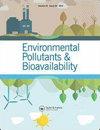Spatial distribution, ecotoxicity and human health assessment of nutrients and heavy metals in river sediment under urbanization – A study case of Yitong River, China
IF 3.2
4区 环境科学与生态学
Q2 BIOCHEMISTRY & MOLECULAR BIOLOGY
Environmental Pollutants and Bioavailability
Pub Date : 2023-09-01
DOI:10.1080/26395940.2023.2248384
引用次数: 0
Abstract
ABSTRACT We investigated the contents and distributions of nutrients and heavy metals in sediment from the Yitong River. The main aims were to analyze heavy metals speciation and evaluate their bioavailability, in order to assess the risks they pose to both ecosystem and human health. The average total nitrogen (TN), total phosphorus (TP), organic matter (OM) and Cd, Cr, Cu, Ni, Pb and Zn contents were 1747.69, 895.58, 75103, 0.19, 75.64, 33.61, 47.17, 56.65 and 159.91 mg kg−1, respectively. Results from acid-extraction fraction analysis showed that the proportions of Cd and Zn ranged from 3.78% to 30.20% and 5.31% to 30.74%, respectively. Health risk assessment model showed the risk index values of children and adults were 0.412 and 0.059, respectively, indicating a minimal threat to human health. Multivariate statistical analyses revealed that TN and TP may have similar sources and could be attributed to combined sewer overflows, while Cr, Cu, Ni and Zn were primarily derived from industrial pollution sources. Toxicity bioassay tests demonstrated that the majority of sediment samples were classified as non-toxic. However, 25% of the samples showed slight toxicity towards Vibrio qinghaiensis Q67, while 7% of the samples exhibited slight toxicity towards Daphnia magna. Based on these findings, it is necessary to implement pollution control measures and conduct assessments of aquatic ecological risks in sediments from urban rivers. These results can be used to develop effective strategies for the management and governance of aquatic sediments.城市化条件下河流沉积物中营养物质和重金属的空间分布、生态毒性及人体健康评价——以伊通河为例
本文章由计算机程序翻译,如有差异,请以英文原文为准。
求助全文
约1分钟内获得全文
求助全文
来源期刊

Environmental Pollutants and Bioavailability
Chemical Engineering-Chemical Health and Safety
CiteScore
4.30
自引率
3.00%
发文量
47
审稿时长
13 weeks
期刊介绍:
Environmental Pollutants & Bioavailability is a peer-reviewed open access forum for insights on the chemical aspects of pollutants in the environment and biota, and their impacts on the uptake of the substances by living organisms.
Topics include the occurrence, distribution, transport, transformation, transfer, fate, and effects of environmental pollutants, as well as their impact on living organisms. Substances of interests include heavy metals, persistent organic pollutants, and emerging contaminants, such as engineered nanomaterials, as well as pharmaceuticals and personal-care products as pollutants.
 求助内容:
求助内容: 应助结果提醒方式:
应助结果提醒方式:


